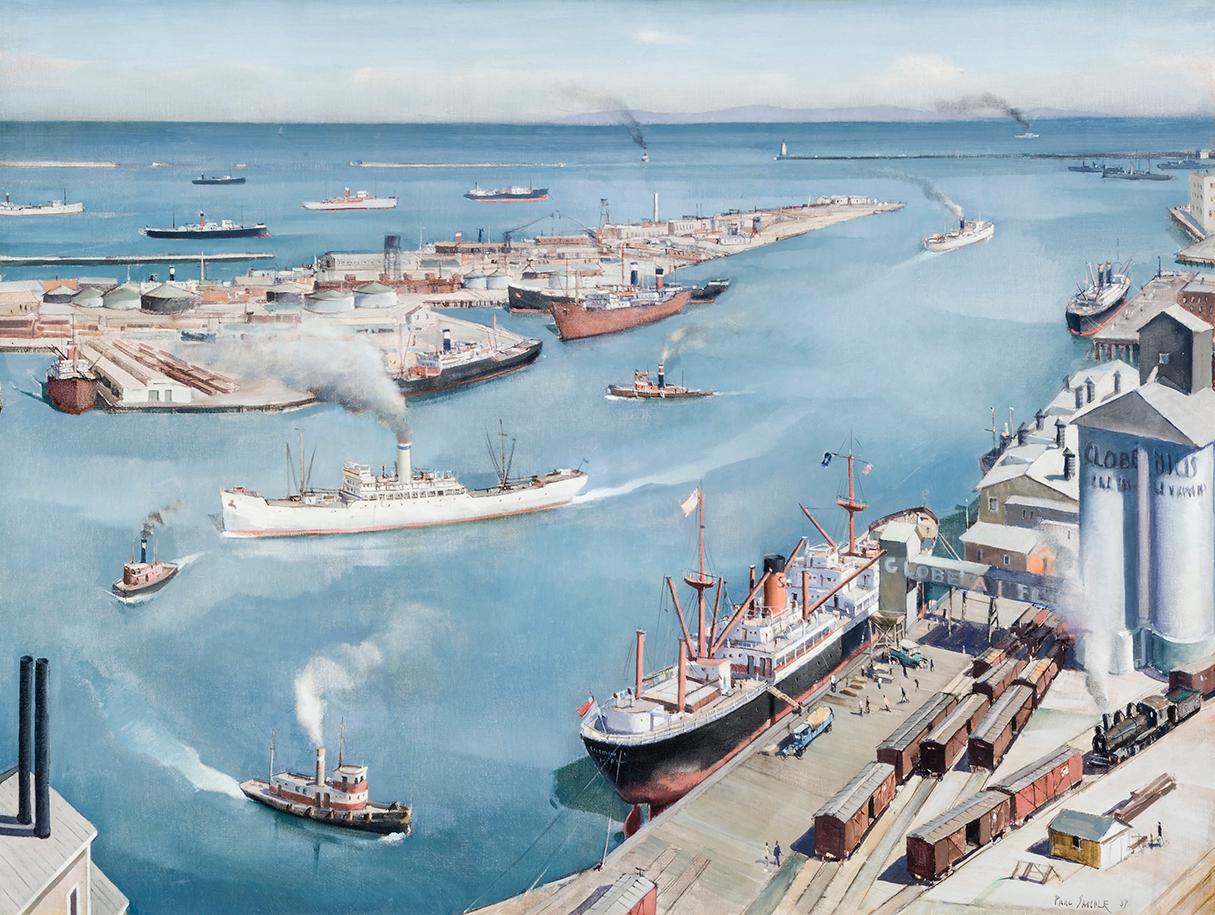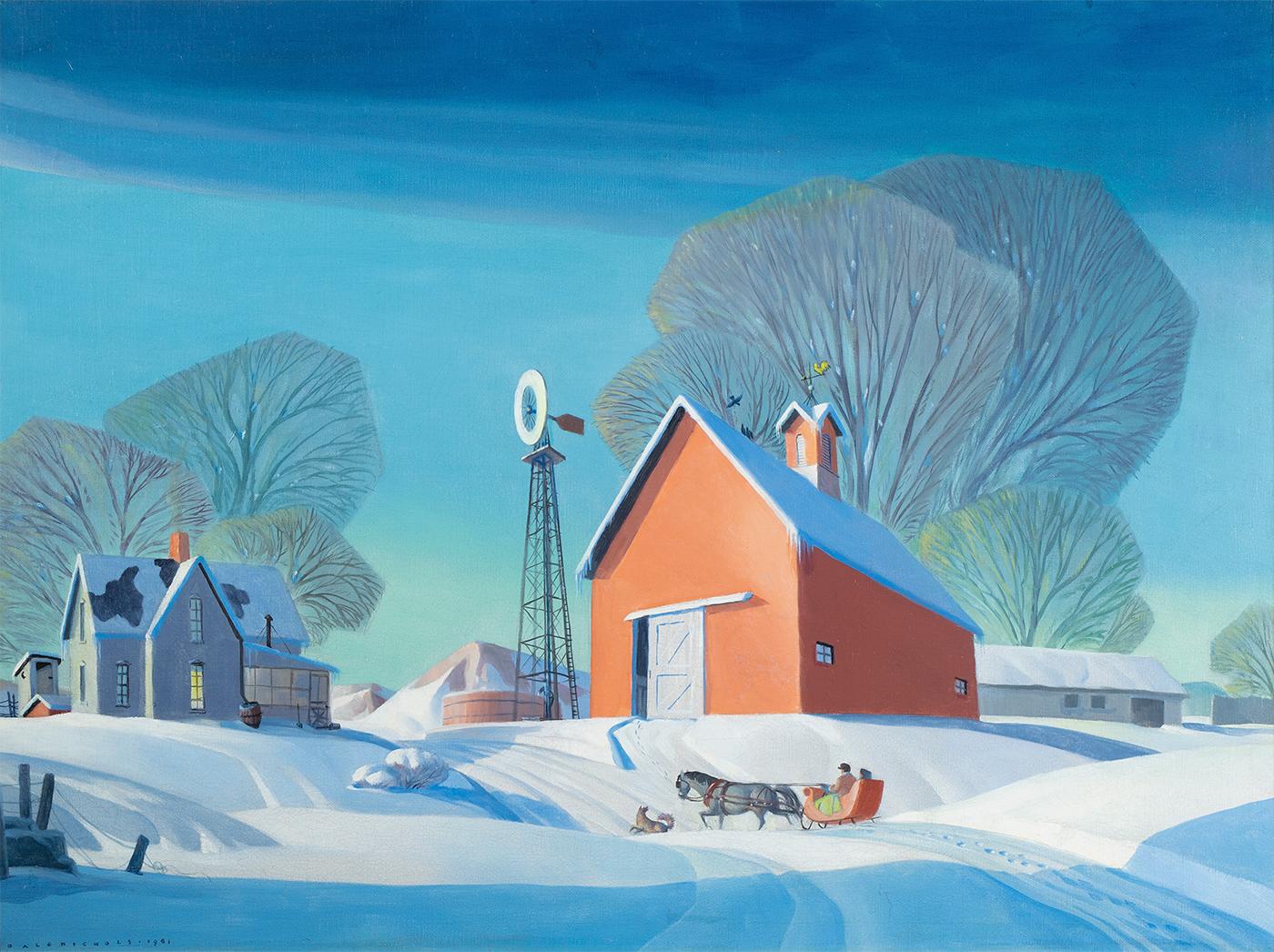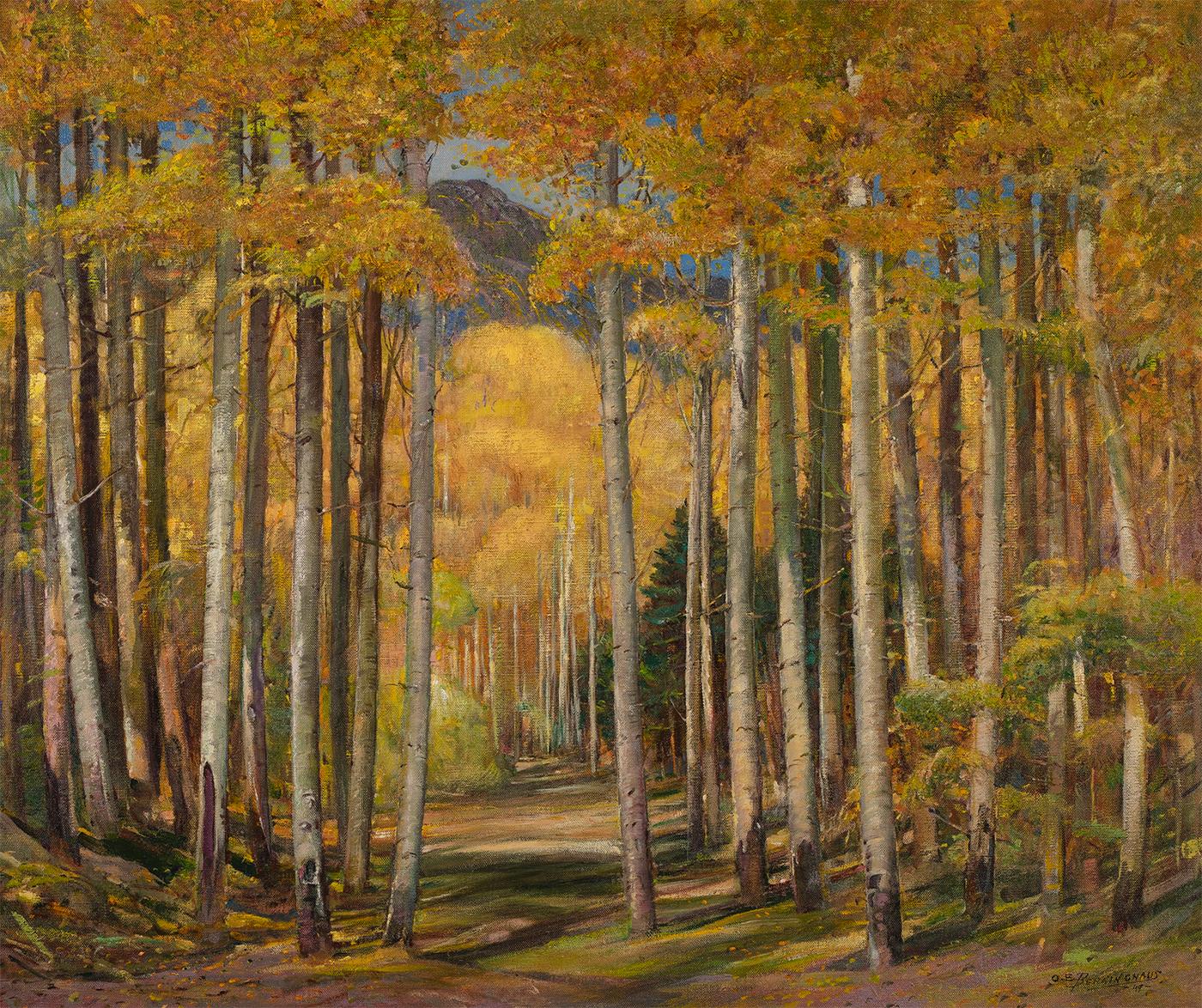Items Similar to Yellow Shore, A landscape along the beach of the North Shore of Long Island
Want more images or videos?
Request additional images or videos from the seller
Stan BrodskyYellow Shore, A landscape along the beach of the North Shore of Long Island 1969
1969
About the Item
This painting on canvas looking out from the shoreline of the beach with dock pilings in the foreground and a yellow field in front of trees across the water. signed on the lower right side by the artist, Stan Brodsky. Much in the style of Fairfield Porter
- Creator:Stan Brodsky (1924, American)
- Creation Year:1969
- Dimensions:Height: 18 in (45.72 cm)Width: 24 in (60.96 cm)
- Medium:
- Movement & Style:
- Period:
- Condition:
- Gallery Location:Brookville, NY
- Reference Number:1stDibs: LU163528899922
Stan Brodsky
Born in Brooklyn, NY 1925
Died NY 1919 Education 1959 Ed.D., Columbia University 1950 M.F.A., Painting, Iowa University 1949 B.J. Photo-Journalism, Missouri University Selected Solo Exhibitions The Impact of Color, essay by Phyllis Braff, June Kelly Gallery, New York Stan Brodsky: The Gesture of Color, Port Washington NY June Kelly Gallery/concurrent with retrospective exhibition, Stan Brodsky: The Figure, 1951-2006, Hofstra University Museum Gallery Merz, Sag Harbor, NY
Gallery North, Setauket, NY June Kelly Gallery, New York
Stan Brodsky: Paintings, Gallery Merz, Sag Harbor, NY Elaine Benson Gallery, Bridgehampton, NY
June Kelly Gallery
The University of Bridgeport, CT
Works from the 90’s, Port Washington
Landscape As Memory, June Kelly Gallery, New York
Sculpture, Paintings & Prints, Gallery North, Setauket, NY New Paintings, June Kelly Gallery/current with retrospective exhibition
The Art of Stan Brodsky, Heckscher Museum of Art, Huntington, NY; catalogue Recent Paintings, June Kelly Gallery, New York New Paintings: Stan Brodsky/Karin Batten, June Kelly Gallery, New York Nassau County Museum of Art, Roslyn, NY Gallery North, Setauket, NY Nassau Community College, Garden City, NY Bloomsburg State College, PA Lubin Alumni House, Syracuse University, NY Lerner-Heller Gallery, New York
Benson Gallery, Bridgehampton, NY Heckscher Museum of Art, Huntington, NY Roko Gallery, New York Selected Group Exhibitions Hofstra University Museum, Hempstead, NY
Children’s Pleasures:Celebrations of Childhood, curated by Donna Barnes, Ph.D.,
Emily Lowe Gallery, Hofstra University Museum, Hempstead, NY; catalogue Long Island Moderns: Artists on the North Shore from Edward Steichen to Cindy Sherman,
Heckscher Museum, Huntington, NY; catalogue
Hidden Gems : Works on Paper, June Kelly Gallery, New York
Art League of Long Island Gallery, Dix Hills, NY Figurative and Historical Paintings and Photographs, Heckscher Museum of Art, Huntington, NY Abstraction at 40, Gallery North, Setauket, NY
10 Artists: Defining Abstraction, organized by the June Kelly Gallery, Pfizer, New York Art Center, Westport, CT
Alpan Gallery, Huntington, NY Inaugural Exhibition, Art League of Long Island
Gallery North, Setauket, NY Alpan Gallery, NY 20th Century Long Island Landscapes, Long Island Public Collections Baltimore Museum of Art, MD
Fine Arts Museum of the South, Mobile, AL
Heckscher Museum of Art, Huntington, NY
Housatonic Museum of Art, Bridgeport, NY
Museum of Fine Arts, St. Petersburg, FL
Parrish Art Museum, Southampton, NY
Pensacola Museum of Art, FL.
Telfair Museum of Art, Savannah, GA
William A. Farnsworth Museum, Rockland, ME
Long Island Museum of American Art, Stony Brook, NY
Guild Hall Museum, East Hampton, NY
Neuberger Museum of Art, Purchase, NY
Delaware University, Newark, DE
New York University, New York
Long Island University, C.W. Post Campus, Brookville, NY
AT&T, Chicago, IL
Campbell Mithun Esty, Southfield, MI
Cold Spring Harbor Laboratory, Cold Spring, NY
Newsday, Melville, NY
Port Authority, World Trade Center, New York
Hyde Collection, Glen Falls, NY
Printmaking Workshop, New York
About the Seller
5.0
Vetted Seller
These experienced sellers undergo a comprehensive evaluation by our team of in-house experts.
Established in 1985
1stDibs seller since 2021
12 sales on 1stDibs
Typical response time: 1 hour
- ShippingRetrieving quote...Ships From: Glen Head, NY
- Return PolicyA return for this item may be initiated within 3 days of delivery.
More From This SellerView All
- Southdown Field at Long Island Sound Beach Parent and childBy Stan BrodskyLocated in Brookville, NYThis large green field overlooking the Long Island Sound Beach depicts a parent without definition, mother or father, observing their child in the gr...Category
1960s American Modern Figurative Paintings
MaterialsOil
- Moon Glow by Robert TerryLocated in Brookville, NYBorn 1955 in Broken Bow, Nebraska. Lives and works in New York. AWARDS National Endowment for the Arts, Major Grant Robert Terry was best noted in his depictions of romantic moons...Category
1990s American Modern Landscape Paintings
MaterialsOil
- New Hampshire A beautiful landscape of a house similar to Fairfield PorterBy Stan BrodskyLocated in Brookville, NYThese earlier works by Stan Brodsky are reminiscent of Fairfield Porter. Stan Brodsky found his path into painting through the landscape. In his paintings of the 1970's, the horizo...Category
Late 20th Century American Realist Landscape Paintings
MaterialsOil
- Sedona Violett 111 a large abstract painting in desert colorsBy Stan BrodskyLocated in Brookville, NYThis large abstract painting of muted desert colors is signed on the lower left side by the artist Stan Brodsky. The oranges, mauves and yellows are mixed in with some green and lav...Category
1990s Abstract Expressionist Abstract Paintings
MaterialsOil
- Hamptons Tennis 2 men playing Tennis, in the manner of Fairfield PorterBy Stan BrodskyLocated in Brookville, NYStan Brodsky enjoyed a prolific period in the 1960's painting figurative paintings and landscapes, much in the manner of Fairfield Porter. He enjoyed being a keen observer of the la...Category
1960s Figurative Paintings
MaterialsOil
- View of VeniceLocated in Brookville, NYVirgilio Ripari was best known for his seascapes and impressions of Venice. His romantic and peaceful paintings of life of Venice and Italy with placid waters or full sails on boats...Category
Mid-19th Century Italian School Landscape Paintings
MaterialsOil
You May Also Like
- San Pedro HarborBy Paul SampleLocated in New York, NYIt is infrequent, to say the least, that a diagnosis of tuberculosis proves fortuitous, but that was the event, in 1921, that set Paul Starrett Sample on the road to becoming a professional artist. (The best source for an overview of Sample’s life and oeuvre remains Paul Sample: Painter of the American Scene, exhib. cat., [Hanover, New Hampshire: Hood Museum of Art, 1988] with a detailed and definitive chronology by Sample scholar, Paula F. Glick, and an essay by Robert L. McGrath. It is the source for this essay unless otherwise indicated.) Sample, born in Louisville, Kentucky, in 1896 to a construction engineer and his wife, spent his childhood moving with his family to the various locations that his father’s work took them. By 1911, the family had landed in Glencoe, Illinois, settling long enough for Paul to graduate from New Trier High School in 1916. Sample enrolled at Dartmouth College, in Hanover, New Hampshire, where his interests were anything but academic. His enthusiasms included the football and basketball teams, boxing, pledging at a fraternity, and learning to play the saxophone. After the United States entered World War I, Sample, to his family’s dismay, signed on for the Naval Reserve, leading directly to a hiatus from Dartmouth. In 1918 and 1919, Sample served in the U.S. Merchant Marine where he earned a third mate’s license and seriously contemplated life as a sailor. Acceding to parental pressure, he returned to Dartmouth, graduating in 1921. Sample’s undergraduate life revolved around sports and a jazz band he formed with his brother, Donald, two years younger and also a Dartmouth student. In November 1933, Sample summarized his life in a letter he wrote introducing himself to Frederick Newlin Price, founder of Ferargil Galleries, who would become his New York art dealer. The artist characterized his undergraduate years as spent “wasting my time intensively.” He told Price that that “I took an art appreciation course and slept thru it every day” (Ferargil Galleries Records, circa 1900–63, Archives of American Art, Smithsonian Institution, available on line). In 1920, Donald Sample contracted tuberculosis. He went for treatment to the world-famous Trudeau Sanitorium at Saranac Lake, in New York State’s Adirondack Mountains for the prescribed regimen of rest, healthful food, and fresh air. Visiting his brother in 1921, Paul also contracted the disease. Tuberculosis is highly contagious, and had no certain cure before the development of streptomycin in 1946. Even for patients who appeared to have recovered, there was a significant rate of recurrence. Thus, in his letter to Price, Sample avoided the stigma conjured by naming the disease, but wrote “I had a relapse with a bad lung and spent the next four years hospitalized in Saranac Lake.” The stringent physical restrictions imposed by adherence to “the cure” required Sample to cultivate an alternate set of interests. He read voraciously and, at the suggestion of his physician, contacted the husband of a fellow patient for instruction in art. That artist, then living in Saranac, was Jonas Lie (1880–1940), a prominent Norwegian-American painter and an associate academician at the National Academy of Design. Lie had gained renown for his dramatic 1913 series of paintings documenting the construction of the Panama Canal (The Metropolitan Museum of Art, New York; United States Military Academy, West Point, New York). Primarily a landscape artist, Lie had a particular affinity for scenes with water. His paintings, impressionistic, atmospheric, and brushy, never strayed from a realistic rendering of his subject. Sample regarded Lie as a mentor and retained a lifelong reverence for his teacher. Sample’s early paintings very much reflect Lie’s influence. ` In 1925, “cured,” Sample left Saranac Lake for what proved to be a brief stay in New York City, where his veteran’s benefits financed a commercial art course. The family, however, had moved to California, in the futile hope that the climate would benefit Donald. Sample joined them and after Donald’s death, remained in California, taking classes at the Otis Art Institute in Los Angeles. In Sample’s account to Price, “I couldn’t stomach the practice of painting a lot of High Sierras and desert flowers which seemed to be the only kind of pictures that were sold here so I got a job teaching drawing and painting at the art school of the University of Southern California.” Initially hired as a part-time instructor, Sample progressed to full-time status and ultimately, by the mid-1930s, to the post of Chairman of the Fine Art Department. Sample, however, did not want to wind up as a professor. “Teaching is all right in small doses,” he wrote, “but I have a horror of drifting into being a college professor and nothing more.” At the same time as he taught, Sample began to exhibit his work in a variety of venues at first locally, then nationally. Though he confessed himself “a terrible salesman,” and though occupied with continued learning and teaching, Sample was nonetheless, ambitious. In 1927, he wrote in his diary, “I am eventually going to be a painter and a damned good one. And what is more, I am going to make money at it” (as quoted by Glick, p. 15). In 1928, Sample felt sufficiently solvent to marry his long-time love, Sylvia Howland, who had also been a patient at Saranac Lake. The Howland family were rooted New Englanders and in summertime the Samples regularly traveled East for family reunion vacations. While the 1930s brought serious hardship to many artists, for Paul Sample it was a decade of success. Buttressed by the financial safety net of his teacher’s salary, he painted realist depictions of the American scene. While his work addressed depression-era conditions with a sympathetic eye, Sample avoided the anger and tinge of bitterness that characterized much contemporary realist art. Beginning in 1930, Sample began to exhibit regularly in juried exhibitions at important national venues, garnering prizes along the way. In 1930, Inner Harbor won an honorable mention in the Annual Exhibition of the Art Institute of Chicago. That same year Sample was also represented in a show at the Albright-Knox Gallery in Buffalo and at the Biennial Exhibition of the Corcoran Gallery of Art, Washington, D.C. In 1931, Dairy Ranch won the second Hallgarten Prize at the Annual Exhibition of the National Academy of Design, in New York. Sample also made his first appearances at the Carnegie Institute, Pittsburgh, and The Pennsylvania Academy of the Fine Arts, Philadelphia. In 1936, Miner’s Resting won the Temple Gold Medal at the Pennsylvania Academy’s Annual Exhibition. Always interested in watercolor, in 1936, Sample began to send works on paper to exhibitions at the Whitney Museum, New York. While participating in juried exhibitions, Sample also cultivated commercial possibilities. His first New York art dealer was the prestigious Macbeth Gallery in New York, which included his work in a November 1931 exhibition. In 1934, Sample joined the Ferargil Galleries in New York, after Fred Price arranged the sale of Sample’s Church Supper to the Michele and Donald D’Amour Museum of Fine Arts in Springfield, Massachusetts. In 1937, The Metropolitan Museum of Art purchased Sample’s Janitor’s Holiday from the annual exhibition of the National Academy of Design, a notable honor. As prestigious as this exhibition schedule may have been, by far Sample’s most visible presence in the 1930s and 1940s was the result of his relationship with Henry Luce’s burgeoning publishing empire, Time, Inc. Sample’s first contribution to a Luce publication appears to have been another San Pedro...Category
20th Century American Modern Landscape Paintings
MaterialsCanvas, Oil
- Winter on the FarmBy Dale NicholsLocated in New York, NYSigned and dated lower left: DALE NICHOLS ∙ 1961Category
20th Century American Modern Landscape Paintings
MaterialsOil
- The Weathered BarnBy Luigi LucioniLocated in New York, NYSigned and dated lower left: L Lucioni 1947Category
20th Century American Modern Landscape Paintings
MaterialsOil
- Autumn Aspen ForestBy Oscar Edmund BerninghausLocated in New York, NYSigned and dated lower right: O.E. BERNINGHAUS. / –49–Category
20th Century American Modern Landscape Paintings
MaterialsOil
- From a BalconyBy Glenn O. ColemanLocated in Miami, FLExhibited: New York Society of Artist Sid Deutsch Owings-Dewey Fine Art It's Skyscraper City: 1918. The artist depicts a simultaneous interior and exerterior view.. Based on Cole...Category
1920s American Modern Landscape Paintings
MaterialsOil
- The Old Monastery WallBy William S. SchwartzLocated in New York, NYSigned (at lower left): WILLIAM S. SCHWARTZCategory
Early 20th Century American Modern Landscape Paintings
MaterialsCanvas, Oil
Recently Viewed
View AllMore Ways To Browse
Vintage Water Sign
Vintage Fairfield
Porter Fairfield
Signed Painting Fairfield Porter
Harrison Marks
Mill Valley
Moon River
Norwich Oil
Pasture Oil Painting
Sea Sailboat Painting
Tree Mountain Water Painting
Newlyn Art
Jean Baptiste Artist
Early West Cowboy Art
C 130
1960s German Landscape Painting
Wooden Santas
Susan Thomas






